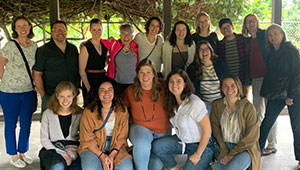Erin Bowles, MPH
Biography
Epidemiologist Erin Bowles, MPH, is looking at breast cancer screening and treatment from many different perspectives. Her research brings new insight into cancer risk factors, diagnosis, treatment, and survivorship, while helping improve cancer care for patients and families.
Erin received an R50 mid-career research award from the National Cancer Institute (NCI). This award is given to cancer researchers who have demonstrated successes and contributions to cancer research as a non-principal investigator. As a key member of 2 large cancer collaborations — the NCI's Breast Cancer Surveillance Consortium and the Kaiser Permanente Breast Cancer Survivors Cohort — Erin has developed diverse expertise that includes reading mammograms for breast density and using administrative data to understand patterns of breast cancer screening and cancer treatment.
Her current work includes:
- Collaborating on a multi-site study with investigators from Memorial Sloan Kettering Cancer Center, Kaiser Permanente Northern California, and Rutgers University to understand how obesity affects chemotherapy treatment dosing and risks of recurrence and toxicity in women with breast cancer
- Helping investigators from Kaiser Permanente Northern California and the University of California (UC) San Francisco and UC Davis understand imaging trends in children and pregnant women, and subsequent risks of leukemia associated with ionizing radiation from imaging exams
- Working with investigators from the NCI, Kaiser Permanente Colorado, Kaiser Permanente Georgia, and Kaiser Permanente Hawaii to study how mammographic breast density, radiation treatment, and tissue biomarkers are associated with second cancers in women with previous breast cancer
- Collaborating on several studies within the BCSC to understand how disparities, access to advanced technology like artificial intelligence, and social drivers of health affect breast cancer screening, diagnosis, and surveillance
- Working with teams from the Centers for Disease Control and Prevention, University of Washington, Henry Ford Health System, and Multicare Health System to develop and validate questions about cancer screening for people eligible for breast, colorectal, cervical, and/or lung cancer screening for the National Health Interview Survey.
Erin’s experience working with large observational cohorts and collaborations with numerous study teams over the past 20+ years has provided her with expertise in data collection and quality control for many subject areas. She is also Director of the Collaborative Science Division at KPWHRI, providing leadership, supervision, mentorship, and support to collaborative scientists with a range of skills and expertise. She is passionate about providing long-term career paths for masters- and PhD-level scientists who don’t want to become independent investigators.
Research interests and experience
-
Cancer
Breast cancer; colorectal cancer; multiple myeloma; thyroid cancer; pancreatic cancer; biostatistics; epidemiology; mammography; mammographic breast density; cancer treatment; cancer screening and surveillance; automated data collection; quality of care; medication use; care coordination; administrative data
-
Health Services & Economics
Access to care; health disparities; health outcomes research; quality of life; measurement of change in health care systems; practice variation
-
Women's Health
Menopause; hormone replacement therapy (HRT); breast cancer
-
Aging & Geriatrics
Cognitive health and dementia; biostatistics; epidemiology; medication use; cancer
-
Medication Use & Patient Safety
Pharmacoepidemiology; observational study research methods; chemotherapy; radiation exposure
Recent publications
Wieneke AE, Bowles EJ, Cronkite D, Wernli KJ, Gao H, Carrell D, Buist DS. Validation of natural language processing to extract breast cancer pathology procedures and results. J Pathol Inform. 2015 Jun 23;6:38. doi: 10.4103/2153-3539.159215. eCollection 2015. PubMed
Jones SM, Ludman EJ, McCorkle R, Reid R, Bowles EJ, Penfold R, Wagner EH. A differential item function analysis of somatic symptoms of depression in people with cancer. J Affect Disord. 2015 Jan 1;170:131-7. doi: 10.1016/j.jad.2014.09.002. Epub 2014 Sep 10. PubMed
Ritzwoller DP, Carroll NM, Delate T, Hornbrook MC, Kushi L, Aiello Bowles EJ, Loggers ET, Menter A. Comparative effectiveness of adjunctive bevacizumab for advanced lung cancer: the Cancer Research Network experience. J Thorac Oncol. 2014 2014 May;9(5):692-701. doi: 10.1097/JTO.0000000000000127. PubMed
Boudreau DM, Yu O, Chubak J, Wirtz HS, Bowles EJ, Fujii M, Buist DS. Comparative safety of cardiovascular medication use and breast cancer outcomes among women with early stage breast cancer. Breast Cancer Res Treat. 2014 Apr;144(2):405-16. doi: 10.1007/s10549-014-2870-5. Epub 2014 Feb 21. PubMed
Aiello Bowles EJ, Wernli KJ, Gray HJ, Bogart A, Delate T, O’Keefe-Rosetti M, Nekhylyudov L, Trice Loggers E. Diffusion of intraperitoneal chemotherapy in women with advanced ovarian cancer in community settings 2003-2008: the effect of the NCI clinical recommendation. Front Oncol. 2014 Mar 10;4:43. doi: 10.3389/fonc.2014.00043. eCollection 2014. PubMed
Wirtz HS, Boudreau DM, Gralow JR, Barlow WE, Gray S, Bowles EJ, Buist DS. Factors associated with long-term adherence to annual surveillance mammography among breast cancer survivors. Breast Cancer Res Treat. 2014 Feb;143(3):541-50. doi: 10.1007/s10549-013-2816-3. Epub 2014 Jan 10. PubMed
Research

Study links medical imaging to cancer risk in children
New research finds that 10% of pediatric blood and bone marrow cancers may have stemmed from radiation exposure.
News

Predicting breast cancer risk after a high-risk benign lesion diagnosis
New study will develop risk models to improve clinical guidelines and practice.
Breast Cancer Surveillance
Kaiser Permanente Washington Breast Cancer Surveillance Registry
Kaiser Permanente Washington has been part of the national Breast Cancer Surveillance Consortium since 1994. Learn about the Kaiser Permanente Washington Breast Cancer Surveillance Registry here.
Healthy Findings Blog

Meet KPWHRI’s collaborative scientists
The division contributes to research across the institute with methodological and subject matter expertise.
KPWHRI in the media
Reduced-dose chemotherapy more common in older women
Erin Bowles on age at breast cancer diagnosis and chemotherapy dose in older women
MedPage Today, March 4, 2025
Research

Improving cancer prevention and early detection
How KPWHRI is contributing to better cancer screening and better outcomes for patients.



